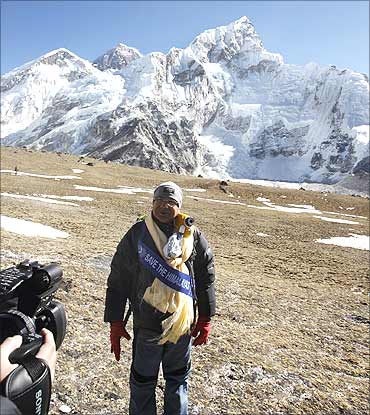
The highly serious issue of climate change and global warming has taken a beating with vital research figures on climate change being distorted and 'falsified'. With contentions over important timelines -- like the melting of the Himalayas -- being disputed, scientific studies that contradict each other are losing credibility.
The Nobel Prize-winning Intergovernmental Panel on Climate Change (IPCC) has now admitted its goof-up on the 'deadline' on the melting of the Himalayan glaciers.
The panel, headed by Rajendra K Pachauri, had claimed that the Himalayan glaciers could melt away by 2035, causing a lively furore . "The clear and well-established standards of evidence, required by the IPCC procedures, were not applied properly," said IPCC in a statement on its website, accepting the error.
Environment Minister Jairam Ramesh said such forecasts were alarmist and without scientific basis.
He also took a dig at the comments made by IPCC chairman R K Pachauri, who had dubbed the Union environment ministry's report, which stated that global warming is not the only reason for glaciers melting, as 'voodoo science'.
Pachauri now faces an embarrassing situation.
Click NEXT to find out just what the issue is all about. . .

Stressing on enhancing scientific capability, Jairam Ramesh said that the most important lesson that India must learn from the whole episode is that there is no substitute for domestic scientific capability.
This is the second time that the world has been proved wrong on its views on climate change and India, the minister said. "The first time was when the United States government estimated in the early 1990s that wet paddy cultivation in Indian fields produced yearly 38 million tonne of methane gas and that this was the second most preponderance for emission of greenhouses gases.
"But it was later established by the India's leading agro-scientist A P Mitra, who challenged the US administration's estimates and found that the emission was four million tonnes per annum on average," Ramesh said, adding the second time was on the 'glacier melting' issue.
"What it shows is that there is no substitute for indigenous study, monitoring and modelling. That is why we have set up a network of scientists and researchers to carry out researches based on our local requirements and conditions," the minister added. Click NEXT to read further. . .

The IPCC, which boasted about its research prowess, now finds itself in the eye of the storm.
"The IPCC doesn't do any research itself. We only develop our assessments on the basis of peer-reviewed literature. So this is really hundreds and thousands of years of research efforts that go into the distinct material that comes into the report," R K Pachauri had said in an interview with rediff.com in 2007.
"You know there may be someone who knows a lot about glaciers. We will get him to write something on glaciers and send it to the writing team. So if you look at all these inputs, you have well over 3,000 people who participate in this process. The IPCC doesn't do any research itself. We only develop our assessments on the basis of peer-reviewed literature. So this is really hundreds and thousands of years of research efforts that go into the distinct material that comes into the report," he said in the interview.
"I can't think of a better process. There is not a parallel on this planet in any field of endeavour as you have in the case of the IPCC," he added.
The IPCC has now said it regretted "the poor application of well-established IPCC procedures in this instance".
"It has recently come to our attention that a paragraph in the 938 page Working Group II contribution to the underlying assessment refers to poorly substantiated estimates of rate of recession and date for the disappearance of Himalayan glaciers," an IPCC statement said in Geneva.
"The Chair, Vice Chair and Co-Chairs of the IPCC regret the poor application of well-established procedures in this instance," it added.
IPCC said the broader assessment remained correct that warming of the earth would lead to widespread losses from the glaciers. The concluding document of the IPCC's Fourth Assessment Report stated: "Climate change is expected to exacerbate current stresses on water resources from population growth and economic and land-use change, including urbanisation". Click NEXT to read further. . .
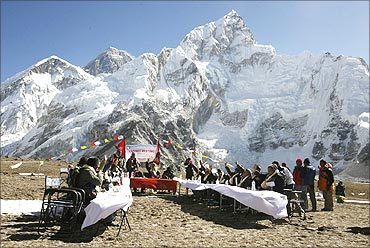
Meanwhile, leading glaciologist and senior fellow at The Energy and Resources Institute, Syed Iqbal Hasnain, who was quoted in New Scientist and Down to Earth magazines as saying Himalayan glaciers were likely to disappear by 2035, defended himself, saying, "I must stress that a journalistic substitution of the year 2035 was made -- without my knowledge and approval -- that was markedly contrary to my research supported finding of the likelihood of the central and eastern Himalayan glaciers disappearing in 40-50 years."
Hasnain had made a presentation at the Centre for Science and Environment in February 1999, where he had talked about the controversial 2035 deadline. The CSE published the details in its magazine Down to Earth.He said IPCC experts had never approached him for his research papers on Himalayan glaciers.
Hasnain also said that technology had improved in recent years and results could be better. "Now we have more sophisticated and accurate instruments and techniques, as compared to those 10 years back. So, precision has increased and the new results are coming out," he added.
He said, he was "a scientist with years of painstaking study, collation and analyses of field experience who relies more on facts and figures, and not an astrologer who may give any date on the demise of glaciers." Click NEXT to read further. . .
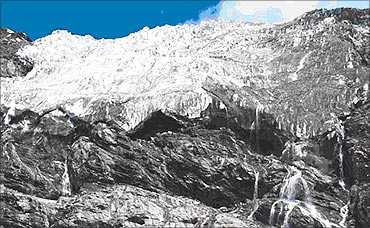
Interestingly, the IPCC study is reported to have taken the deadline on the melting of the Himalayas from a Russian study, which predicted the melting of the glaciers by 2350. IPCC changed it to 2035, making it a 'Himalayan' blunder.
The IPCC also took references from a study done by World Wildlife Fund, which carried a report based on an article in a magazine called New Scientist in 1999. The magazine had attributed the report to statements from Prof Syed Iqbal Hasnain.
Now the WWF admitted that its 2005 report 'contained erroneous information'. "Although scientists remain deeply concerned about glacier retreat in that region, this particular prediction has subsequently proved to be incorrect," the WWF said in a statement. Click NEXT to read further. . .
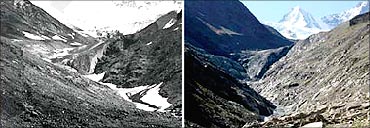
This is what the controversial study quoting various sources states:
'Himalayan glaciers cover about 3 million hectares or 17 per cent of the mountain area as compared to 2.2 per cent in the Swiss Alps. They form the largest body of ice outside the polar caps and are the source of water for the innumerable rivers that flow across the Indo-Gangetic plains.'
'Himalayan glacial snowfields store about 12,000 km3 of freshwater. About 15,000 Himalayan glaciers form a unique reservoir that supports perennial rivers such as the Indus, Ganga and Brahmaputra which, in turn, are the lifeline of millions of people in South Asian countries (Pakistan, Nepal, Bhutan, India and Bangladesh).'
'The Gangetic basin alone is home to 500 million people, about 10 per cent of the total human population in the region.'
'Glaciers in the Himalayas are receding faster than in any other part of the world and, if the present rate continues, the likelihood of them disappearing by the year 2035 and perhaps sooner is very high if the Earth keeps warming at the current rate. Its total area will likely shrink from the present 500,000 km2 to 100,000 km2 by the year 2035 (WWF, 2005).'
'The receding and thinning of Himalayan glaciers can be attributed primarily to global warming due to an increase in the anthropogenic emission of greenhouse gases.'
'The relatively high population density near these glaciers and consequent deforestation and land-use changes have also adversely affected these glaciers. The 30.2-km-long Gangotri glacier has been receding alarmingly in recent years.'
'Between 1842 and 1935, the glacier was receding at an average of 7.3 meters every year; the average rate of recession between 1985 and 2001 is about 23 meters per year (Hasnain, 2002).'
'The current trends of glacial melts suggest that the Ganga, Indus, Brahmaputra and other rivers that criss-cross the northern Indian plain could likely become seasonal rivers in the near future as a consequence of climate change and could likely affect the economies in the region.' Click NEXT to read further. . .
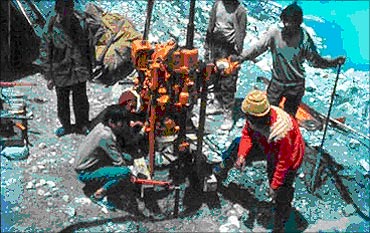
The controversy over the Himalayas melting deadline started in India last year with many scientists contradicting the IPCC statement.
"The health of the glaciers is a cause of grave concern but the Intergovernmental Panel on Climate Change's (IPCC) alarmist position that the 'glaciers will vanish by 2035' was not based on an iota of scientific evidence," Jairam Ramesh said.
"In fact, we had issued a report (by scientist V K Raina) that the glaciers have not retreated abnormally. That time we were dismissed, saying it was based on 'voodoo science'. But the new report has clearly vindicated our position," Ramesh said.
The study released by the environment ministry last year said Himalayan glaciers were not shrinking at the rate that scientists have warned. Click NEXT to read further. . .
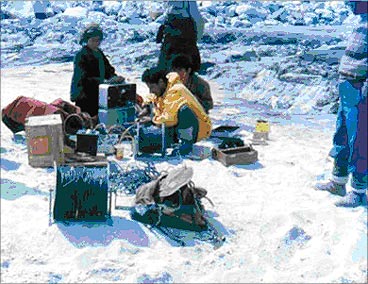
According to his study, the glaciers in the Himalayas, over a period of the last 100 years, behave in contrasting ways. For example, Sonapani glacier has retreated by about 500 meters during the last 100 years. On the other hand, Kangriz glacier has practically not retreated even an inch in the same period.
Siachen glacier is believed to have shown an advance of about 700 meters between 1862 and 1909, followed by an equally rapid retreat of around 400 meters between 1929 and 1958, and hardly any retreat during the last 50 years.
Gangotri glacier, which had hitherto been showing a rather rapid retreat, along its glacier front, at an average of around 20 meters per year till up to 2000 AD, has since slowed down considerably, and between September 2007 and June 2009 is practically at a standstill.
Meanwhile, the Indian government is in talks with China to monitor the glaciers in the Himalayas and plans to collaborate in climate change negotiations.
While the controversy rages over the exact date, scientists across the world agree that global warming is a huge threat to the mighty Himalayas. It time to act, to work jointly towards maintaining ecological balance before it is too late.